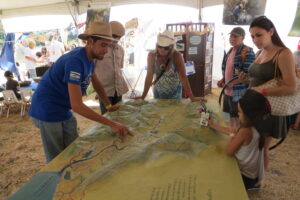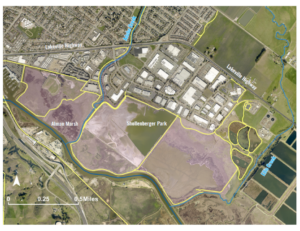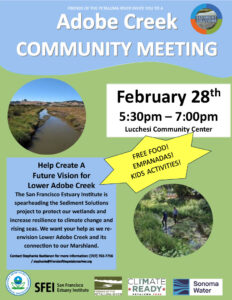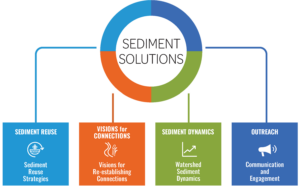 What is Your Vision for Lower Adobe Creek?
What is Your Vision for Lower Adobe Creek?
Join Friends and the San Francisco Estuary Institute as we prepare for a future of rising seas in the SF Bay Area. Sediment is becoming an increasingly precious resource for maintaining critical wetland habitat along the shoreline around San Francisco Bay. As sea level rises, sediment needs to deposit on baylands (marshes and mudflats) to allow them to rise in elevation and continue to provide vital ecosystem services. However, there may not be enough sediment naturally reaching San Francisco’s tidal marshes to keep pace with sea level rise. This may mean greater flood risk, loss of marsh habitat and biodiversity, decreased water filtration, and reduced drawdown of carbon.
As part of the Sediment Solutions project, we want to hear from you as we create a future vision for Lower Adobe Creek. Adobe Creek is vital habitat for steelhead and other threatened species that thrive in the marsh environment of the SF Bay. Many years ago it was channeled and disconnected from the surrounding Marsh. We want to explore with you what a future Lower Adobe Creek could look like that would allow wildlife and humans to thrive while increasing our resilience to climate change.
Lower Adobe Creek Vision Meeting
Wednesday, February 28th | 5:30pm – 7pm @ Lucchesi Community Center
Join Friends, SFEI, Sonoma Water and others as we explore this area of the Petaluma Watershed and envision together a brighter future
Free Food! Kids Activities! Storytelling with Ane Carla Rovetta!
CLICK HERE TO LET US KNOW IF YOU CAN ATTEND!
Sediment Solutions is a timely and innovative project that builds on SFEI’s past work, operationalizing cutting-edge science to inform management approaches that take advantage of natural processes to provide more creek sediment to baylands, increase climate resilience, and enhance creek health. With study areas in North Bay, East Bay, and South Bay, the project will provide new guidance for management strategies that support flood risk management and ecosystem health benefits throughout the region.
The project’s findings and outputs will be shared widely through a series of workshops and presentations, as well as via the project website. Funding for the project comes from the EPA’s Water Quality Improvement Fund and Sonoma County Water Agency (Sonoma Water).


